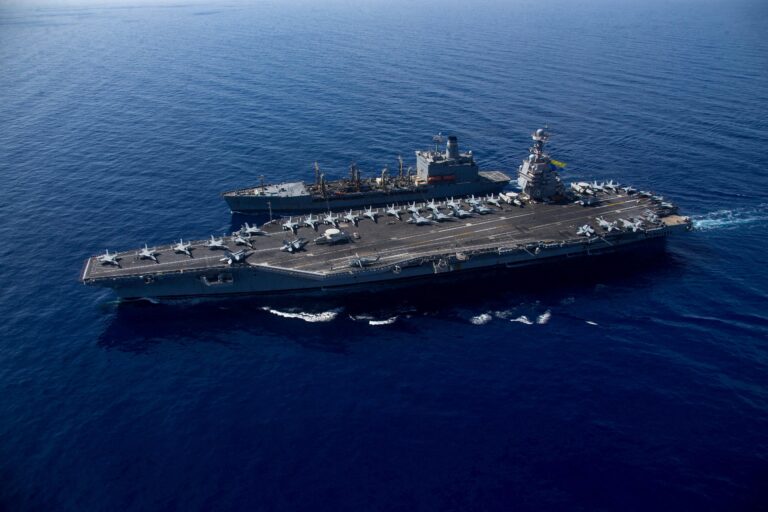U.S. Navy’s Aircraft Carrier Operations in the Middle East: Rising Demands and Strategic Significance
Escalating Operational Challenges Amid Persistent Carrier Deployments
The United States Navy’s persistent deployment of aircraft carriers in the Middle East has increasingly tested the limits of its operational capacity. Recent figures indicate a surge in the number of carrier strike groups stationed concurrently in the region, reflecting the U.S.’s strategic emphasis on maintaining maritime dominance and regional influence. This continuous naval presence, while vital for deterrence and security, imposes substantial pressure on both personnel and equipment, necessitating accelerated maintenance schedules and enhanced logistical coordination to sustain mission readiness.
Primary operational challenges include:
- Prolonged deployment periods affecting crew endurance and morale
- Intensified maintenance demands due to high operational tempo
- Complex coordination efforts with allied naval forces in the region
- Increased consumption of fuel and supplies requiring robust resupply chains
| Month | Number of Carrier Deployments | Average Deployment Duration (Days) |
|---|---|---|
| January 2024 | 3 | 145 |
| February 2024 | 4 | 152 |
| March 2024 | 4 | 158 |
Impact on Fleet Readiness and Maintenance: A Closer Look at Deployment Strains
Data from recent deployments reveal mounting challenges in sustaining fleet readiness as U.S. aircraft carriers operate at an unprecedented pace in the Middle East. The extended time at sea accelerates wear and tear on critical systems, leading to longer maintenance backlogs and increased repair demands. Navy leadership has voiced concerns regarding the long-term viability of these deployment cycles, warning that the relentless operational tempo could degrade combat effectiveness and compel a reassessment of mission priorities to safeguard essential naval assets.
Specific areas of concern include:
- Maintenance delays: Shipyards report extended turnaround times for carrier overhauls and air wing servicing, impacting future deployment schedules.
- Crew fatigue: Despite more frequent personnel rotations, the prolonged deployments contribute to operational exhaustion among sailors and aviators.
- Logistical complexity: Supply chains face increased challenges due to shifting security conditions and the need for rapid resupply in contested waters.
| Carrier | Deployment Length (Days) | Maintenance Delay (Weeks) | Crew Rotation Interval |
|---|---|---|---|
| USS Gerald R. Ford | 240 | 7 | Every 42 days |
| USS John C. Stennis | 225 | 5 | Every 48 days |
| USS Carl Vinson | 215 | 6 | Every 44 days |
Strategic Consequences of Prolonged Carrier Deployments in the Middle East
The unwavering presence of U.S. aircraft carriers in the Middle East serves as a powerful instrument of deterrence and influence, reinforcing America’s ability to project power across critical maritime corridors. This persistent naval footprint plays a pivotal role in safeguarding vital shipping lanes and energy routes, which are essential to global economic stability. Moreover, the continuous carrier deployments act as a strategic counterweight to regional adversaries, while simultaneously bolstering alliances through visible demonstrations of commitment and shared security objectives.
Strategic benefits include:
- Deterrence reinforcement: Demonstrating overwhelming force to dissuade hostile actions.
- Swift crisis intervention: Enabling rapid deployment of air and missile assets to emerging conflict zones.
- Operational versatility: Supporting simultaneous missions across multiple theaters without compromising presence.
| Metric | Regional Stability Impact |
|---|---|
| Annual Carrier Presence (Days) | Over 350 days, ensuring near-continuous maritime surveillance |
| Number of Carriers Deployed | Typically 1-2, balancing operational reach and resource management |
| Response Time to Crises | Less than 24 hours, enabling rapid force projection |
Strategies to Bolster Fleet Durability and Optimize Forward Deployment
To maintain operational effectiveness amid the increasing demands of Middle East deployments, the U.S. Navy must implement comprehensive strategies that enhance fleet resilience and adaptability. Embracing rotational deployment models can distribute operational burdens more evenly across carrier strike groups, while predictive maintenance technologies can minimize downtime by anticipating system failures before they occur. Furthermore, advancing multi-domain warfare capabilities and distributed lethality concepts will empower carrier groups to operate more effectively in contested environments.
Modernizing forward deployment approaches should also focus on:
- Strengthening allied interoperability: Expanding joint exercises and communication networks with regional partners to improve coordinated responses.
- Establishing forward logistics hubs: Creating strategically placed supply and repair facilities to streamline support during extended missions.
- Integrating unmanned platforms: Deploying unmanned aerial and surface vehicles to enhance surveillance and reduce risk to manned assets.
| Focus Area | Anticipated Advantage |
|---|---|
| Predictive Maintenance | Reduced downtime and increased sortie generation |
| Allied Interoperability | Improved joint operational effectiveness and rapid response |
| Unmanned Systems Integration | Extended ISR capabilities and enhanced force protection |
Conclusion: Navigating the Future of Maritime Power Projection in the Middle East
The intensification of aircraft carrier deployments in the Middle East highlights the increasing strategic demands placed on the U.S. Navy’s fleet. As allied nations also enhance their naval contributions, the United States faces the complex task of balancing global commitments with the evolving security landscape of this critical region. These shifting deployment patterns mark a transformative phase in maritime strategy, necessitating ongoing attention from defense planners and policymakers to ensure sustained naval superiority and regional stability. USNI News remains committed to providing up-to-date analysis on these pivotal developments.







